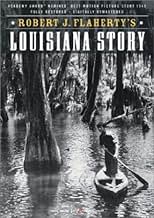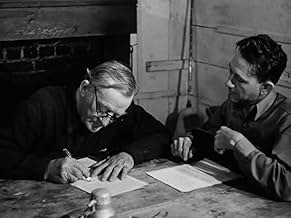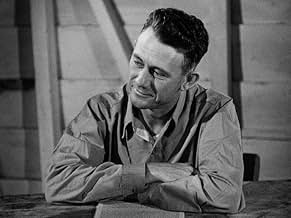IMDb RATING
6.5/10
2.2K
YOUR RATING
The idyllic life of a young Cajun boy and his pet raccoon is disrupted when the tranquility of the bayou is broken by an oil well drilling near his home.The idyllic life of a young Cajun boy and his pet raccoon is disrupted when the tranquility of the bayou is broken by an oil well drilling near his home.The idyllic life of a young Cajun boy and his pet raccoon is disrupted when the tranquility of the bayou is broken by an oil well drilling near his home.
- Nominated for 1 Oscar
- 4 wins & 3 nominations total
- Director
- Writers
- All cast & crew
- Production, box office & more at IMDbPro
Storyline
Did you know
- TriviaStandard Oil of New Jersey (became Exxon in 1972 and Exxon/Mobil in 1999) contributed $258,000 to the film's production. Although the company had no rights and no identification in the film, it stood "to get across the idea that oil companies are beneficently public-spirited, their employees honest, industrious and amiable, and their operations productive and innocuous." According to a modern source, Robert J. Flaherty's contract with Standard Oil insured that all of the film's profits went to him. The only connection was that Humble Derrick No. 1 is mentioned - and the Humble Oil Co. was 50% owned by Standard Oil of New Jersey at the time.
- GoofsIn the opening sequence, when The Boy first spots the raccoon, his hair is neat. Then it's mussed. Then it's neat again.
- ConnectionsFeatured in Studies for Louisiana Story (1965)
Featured review
If you appreciate black and white cinematography, then you will delight in seeing the restored version of this movie on DVD. Cinematographer Richard Leacock and director Flaherty have teamed up to be the Ansel Adams of the film world. This is one of the most cinematic of films - its power and magic lie in the poetry of the images. The score by Virgil Thomson deserved its Pulitzer Prize for music in 1949; it receives a first class performance here by the Philadelphia Orchestra under Eugene Ormandy.
Some have commented on the weak story, but I rather enjoyed it - it could be billed as "Huckleberry Finn meets Standard Oil." The story is told through the eyes of a young Cajun who lives with his grandfather and mother in a simple cabin in the Louisiana marshland. In the opening shots we see the boy exploring the bayous in his canoe with his pet raccoon. He has an elemental bond with his natural environment that made me jealous. The boy's grandfather signs a lease allowing Humble Oil to drill a wildcat well on the bayou near his cabin. We share the boy's wonder at seeing the oil derrick being floated into position and his excitement in being invited onto the rig to follow the drilling up close.
From the viewpoint of a more environmentally conscious time some sixty years later, the benevolent portrayal of the oil industry seems a bit quaint, but that a young boy should be fascinated by the process seems genuine, in any era. In fact I found the details on the drilling captivating, particularly the way those scenes were filmed as a ballet with the roustabouts moving to the rhythms of their work accompanied by the clanking of pipes and chugging of engines.
I had a problem with how delighted the grandfather and mother were at being able just to buy a few gifts from the profits of oil having been struck on their land. While the company to whom they had leased their land was making mucho bucks, it looks like the family got a few hundred dollars. Given the fact that this movie was commissioned by Standard Oil, I am sure that it was not the intent to make the company appear so greedy, but maybe that's one thing that hasn't changed in sixty years.
Joseph Boudreaux as the young boy is endearing and Lionel Le Blanc is believable as the crusty grandfather. All the actors appear to be locals - this adds authenticity, but also presents a problem in that they are not greatly skilled when it comes to delivering their lines. But there is minimal dialog and what there is is hardly necessary as the music and images carry you along.
The DVD has several interesting extras, one of them being a reading of some letters from Richard Leacock (postmarked from Abbeville, Louisiana) to his wife during the long filming. In one letter he says that they ran across the twelve-year-old Boudreaux in a café in Cameron, Louisiana. He had an Acadian accent, had trapped with his father, could handle a Cajun pirogue, and had an infectious smile. They figured he was perfect for the part but, since he was born out of wedlock and under-aged, there were significant difficulties under Louisiana law to be worked out before he could be signed on. Leacock's letters are quite frank. In one he notes that there was buzz about the visit from the director of all Standard Oil public relations and that Flaherty did not like him, referring to him as "the old bastard."
This is a wonderful film in the literal sense of the word wonderful.
Some have commented on the weak story, but I rather enjoyed it - it could be billed as "Huckleberry Finn meets Standard Oil." The story is told through the eyes of a young Cajun who lives with his grandfather and mother in a simple cabin in the Louisiana marshland. In the opening shots we see the boy exploring the bayous in his canoe with his pet raccoon. He has an elemental bond with his natural environment that made me jealous. The boy's grandfather signs a lease allowing Humble Oil to drill a wildcat well on the bayou near his cabin. We share the boy's wonder at seeing the oil derrick being floated into position and his excitement in being invited onto the rig to follow the drilling up close.
From the viewpoint of a more environmentally conscious time some sixty years later, the benevolent portrayal of the oil industry seems a bit quaint, but that a young boy should be fascinated by the process seems genuine, in any era. In fact I found the details on the drilling captivating, particularly the way those scenes were filmed as a ballet with the roustabouts moving to the rhythms of their work accompanied by the clanking of pipes and chugging of engines.
I had a problem with how delighted the grandfather and mother were at being able just to buy a few gifts from the profits of oil having been struck on their land. While the company to whom they had leased their land was making mucho bucks, it looks like the family got a few hundred dollars. Given the fact that this movie was commissioned by Standard Oil, I am sure that it was not the intent to make the company appear so greedy, but maybe that's one thing that hasn't changed in sixty years.
Joseph Boudreaux as the young boy is endearing and Lionel Le Blanc is believable as the crusty grandfather. All the actors appear to be locals - this adds authenticity, but also presents a problem in that they are not greatly skilled when it comes to delivering their lines. But there is minimal dialog and what there is is hardly necessary as the music and images carry you along.
The DVD has several interesting extras, one of them being a reading of some letters from Richard Leacock (postmarked from Abbeville, Louisiana) to his wife during the long filming. In one letter he says that they ran across the twelve-year-old Boudreaux in a café in Cameron, Louisiana. He had an Acadian accent, had trapped with his father, could handle a Cajun pirogue, and had an infectious smile. They figured he was perfect for the part but, since he was born out of wedlock and under-aged, there were significant difficulties under Louisiana law to be worked out before he could be signed on. Leacock's letters are quite frank. In one he notes that there was buzz about the visit from the director of all Standard Oil public relations and that Flaherty did not like him, referring to him as "the old bastard."
This is a wonderful film in the literal sense of the word wonderful.
- How long is Louisiana Story?Powered by Alexa
Details
Box office
- Budget
- $258,000 (estimated)
- Runtime1 hour 18 minutes
- Color
- Aspect ratio
- 1.37 : 1
Contribute to this page
Suggest an edit or add missing content








